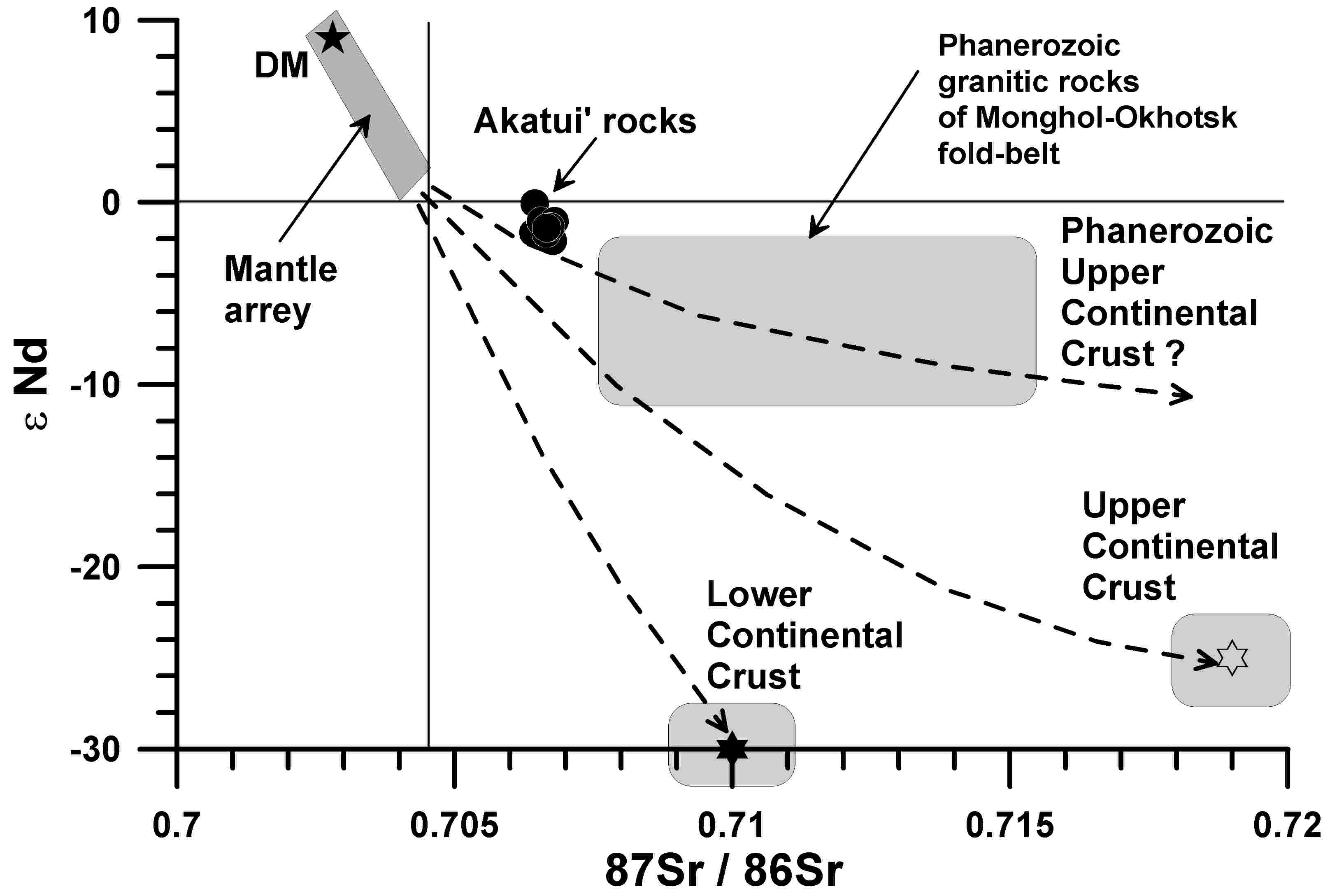|
GEOCHEMISTRY AND Sr-Nd-Pb ISOTOPE SYSTEMATIZATION OF ROCKS OF THE AKATUI MASSIF (SOUTHEAST TRANSBAIKALIA) Sasim S.A., Dril S.I., Tatarnikov S.A., Vladimirova T.A., Sandimirova G.P. Institute of Geochemistry SB RAS, Irkutsk, Russia, sdril@igc.irk.ru
During the whole Phanerozoic the Siberian paleocontinent had been contacting with mantle plumes, which presumably belonged to the African-Atlantic hot field of the mantle (Yarmolyuk, Kovalenko, Kuzmin, 2000). In the Mesozoic the Mongol-Okhotsk paleoocean which was closing at that time as well as adjacent areas experienced the influence of intensive intraplate processes. Transferring of the Mongol-Okhotsk folded belt to the intracontinental stage was accompanied in the Jurassic by abundant shoshonite-latite magmatic occurrences (Tauson, Antipin, Zakharov, Zubkov, 1984, Antipin, 1992). Intrusive rocks of the Akatui massif in the Southeast Transbaikalia are considered to be a classical example of shoshonite-latite magmatic occurrences. The Akatui massif includes olivine monzonites, monzogabbro, monzonites, quartz monzonite and syenite-porphyries. Their age is considered to be 166-147 Ma (Tauson, Antipin, Zakharov, Zubkov, 1984) that corresponds to the Middle-Late Jurassic.
Fig. 1. Multicomponent diagram for rocks of the Akatui massif, Southeast Transbaikalia.
The multicomponent diagram for rocks of the first and second (major) phases of the Akatui massif shows that as opposed to an average composition of OIB basalts they are essentially enriched by such groups of elements, as LILE, LREE, Th, U, and are depleted by HFSE and P (Fig. 1). The interaction of the mantle and crust sources has been traditionally considered as one of the major components of the model which describes the origin and evolution of melts of shoshonite-latite series (Tauson, Antipin, Zakharov, Zubkov, 1984). On the multicomponent diagram the distribution pattern of trace elements in rocks of the Akatui massif is similar to that for an average composition of the upper continental crust. However, the rocks of the Akatui massif show higher accumulation of the majority of incompatible elements (Fig. 1). This fact restrains the application of the model of the crust contamination of the basic melt by the crust substance in order to explain the increased contents of such elements as LILE and LREE in rocks of the Akatui massif. On the other hand, high enrichment of melts from shoshonite-latite series by incompatible and volatile elements was related to melting of the mantle source of the enriched type (Tauson, Antipin, Zakharov, Zubkov, 1984). We estimated a possible significance of various sources of the substance for originating rocks of the Akatui massif using Sr-Nd-Pb isotope data. Intrusive rocks of the massif demonstrate rather increased values of 87Sr/86Sr (0), being in the range from 0, 70644 to 0, 70677, and negative εNd (0) = (-2,1) - (-0,2) values that can be related to the contamination of the primary mantle melt by the matter of the continental crust (Fig. 2). The composition of this crust component should be characterized by εNd (-10), that distinguishes it from the standard average compositions of the upper (εNd = -25) or the lower continental crust (εNd = -30). We suggest, that the Phanerozoic continental crust of the region, which is mainly composed of deposits of accretion wedges and island arcs might have such isotope composition. Features of isotope Pb composition in rocks of the Akatui massif verify the above conclusions made using trace element and Sr-Nd isotope characteristics. On the diagram 207/204Pb/206/204Pb compositional points of rocks from the Akatui massif lie between plots of isotope evolution of lead of the mantle and the upper crust, indicating mixing of lead from both reservoirs in intrusive rocks. Thus, melts of shoshonite-latite series of East Transbaikalia generated with participation of at least two sources of the matter - mantle, most likely enriched one, and the subordinate upper crust substratum.
Fig. 2. The isotope diagram εNd(0)-87Sr/86Sr(0) for rocks of the Akatui massif, Southeast Transbaikalia.
Studies were supported by RFBR 05-05-64332, 06-05-64754, 08-05-00660.
References Yarmolyuk V.V., Kovalenko V. I, Kuzmin M. I. North Asian plume in the Phanerozoic and deep-seated geodynamics//Geotectonics. 2000. №5. P.3-29. Antipin V.S. Geochemical evolution of calc-alkaline and subalkaline magmatism. Nauka. Novosibirsk. 1992. 210p. Tauson L.V., Antipin V. S, Zakharov M. N, Zubkov V. S. Geochemistry of the Mesozoic latites of Transbaikalia. Novosibirsk. Nauka. 1984. 205p.
|

